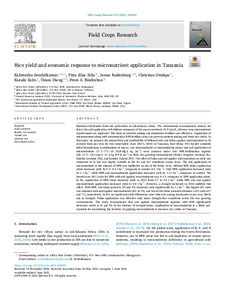| dc.contributor.author | Senthilkumar, K. |
| dc.contributor.author | Sillo, F. S. |
| dc.contributor.author | Rodenburg, J. |
| dc.contributor.author | Dimkpa, C. |
| dc.contributor.author | Saito, K. |
| dc.contributor.author | Dieng, I. |
| dc.contributor.author | Bindraban, P. |
| dc.date.accessioned | 2021-12-21T09:16:45Z |
| dc.date.available | 2021-12-21T09:16:45Z |
| dc.date.issued | 2021-08-01 |
| dc.identifier.citation | Senthilkumar, K., Sillo, F.S., Rodenburg, J., Dimkpa, C., Saito, K., Dieng, I. & Bindraban, P.S. (2021). Rice yield and economic response to micronutrient application in Tanzania. Field Crops Research, 270, 108201, 1-11. |
| dc.identifier.issn | 0378-4290 |
| dc.identifier.uri | https://hdl.handle.net/20.500.12478/7297 |
| dc.description.abstract | Nutrient deficiencies limit rice production in sub-Saharan Africa. The conventional recommended remedy for this is the soil application of fertilizers composed of the macro-nutrients, N, P and K, whereas crop micronutrient requirements are neglected. This leads to nutrient mining and diminished fertiliser use efficiency. Application of micronutrients along with recommended NPK fertiliser rates can prevent nutrient mining and boost rice yields. In this study, we assessed the productivity and profitability of different soil- and foliar-applied micronutrients in 30 on-farm trials per year for two consecutive years (2015, 2016) in Tanzania, East Africa. Five locally available foliar formulations (combinations of macro- and micronutrients or micronutrients alone) and soil application of micronutrients (3−2−7.5−10 Zn-B-Mg-S kg ha–1) were assessed under two NPK-fertilization regimes (80−17.5−33.2 and 0−0−0 kg N-P-K ha–1) in three rice growing environments (RGEs): Irrigated Lowland (IL), Rainfed Lowland (RL), and Rainfed Upland (RU). The effect of foliar and soil applied micronutrients on yield was consistent in IL but was highly variable in the RL and RU conditions across years. The soil application of micronutrients in the absence of NPK was ineffective in any of the RGEs. In IL, without NPK, foliar application alone increased yield by 0.3−0.4 t ha–1, compared to control (3.1 t ha–1). Only NPK application increased yield by 1 t ha–1, while NPK and micronutrients application increased yield by 1.5 t ha–1, compared to control. The benefit-cost (B:C) ratio for NPK with soil applied micronutrients was 4–4.5 compared to NPK application alone. In RL, application of NPK alone increased yield in 2015 from 2.7 to 5.0 t ha–1 while NPK and soil applied micronutrients application increased yield to 6.8 t ha–1. However, a drought incidence in 2016 nullified this effect. With NPK, two foliar products (F2 and F3) increased yield significantly by 1 t ha–1. The highest B:C ratio was obtained with soil applied micronutrients (B:C of 14), and two of the foliar products obtained a B:C ratio of 7 and 7.2, respectively. In RU, no significant yield differences were observed among treatments in any year, likely due to drought. Foliar application was effective only under drought-free conditions across the rice growing environments. This study demonstrated that soil applied micronutrients together with NPK significantly increased yields in IL and RL in the absence of drought-stress. Application of macronutrients is a likely prerequisite for maximizing the benefits of applying micronutrients to increase rice yields in Tanzania. |
| dc.description.sponsorship | African Development Bank |
| dc.description.sponsorship | German Federal Ministry for Economic Cooperation and Development |
| dc.format.extent | 1-11 |
| dc.language.iso | en |
| dc.subject | Agricultural Products |
| dc.subject | Cost Benefit Analysis |
| dc.subject | Upland Rice |
| dc.subject | Sub-Saharan Africa |
| dc.title | Rice yield and economic response to micronutrient application in Tanzania |
| dc.type | Journal Article |
| cg.contributor.crp | Rice |
| cg.contributor.affiliation | Africa Rice Center |
| cg.contributor.affiliation | The Connecticut Agricultural Experiment Station |
| cg.contributor.affiliation | International Institute of Tropical Agriculture |
| cg.contributor.affiliation | International Fertilizer Development Center |
| cg.coverage.region | Africa |
| cg.coverage.region | East Africa |
| cg.coverage.country | Tanzania |
| cg.coverage.hub | Eastern Africa Hub |
| cg.researchtheme | Nutrition and Human Health |
| cg.identifier.bibtexciteid | SENTHILKUMAR:2021 |
| cg.isijournal | ISI Journal |
| cg.authorship.types | CGIAR and advanced research institute |
| cg.iitasubject | Agronomy |
| cg.iitasubject | Plant Breeding |
| cg.iitasubject | Plant Production |
| cg.iitasubject | Socioeconomy |
| cg.iitasubject | Value Chains |
| cg.journal | Field Crops Research |
| cg.notes | Published online: 06 Jun 2021 |
| cg.accessibilitystatus | Limited Access |
| cg.reviewstatus | Peer Review |
| cg.usagerightslicense | Copyrighted; all rights reserved |
| cg.targetaudience | Scientists |
| cg.identifier.doi | https://dx.doi.org/10.1016/j.fcr.2021.108201 |
| cg.futureupdate.required | No |
| cg.identifier.issue | 108201 |
| cg.identifier.volume | 270 |

